Axial Compression Performance of L-Shaped Partially Encased Steel–Concrete Composite Stub Columns
Abstract
:1. Introduction
2. Experimental Investigation
2.1. Details of Columns
2.2. Material Properties
2.2.1. Steel
2.2.2. Concrete
2.3. Setup and Measurement
2.4. Experimental Results and Analysis
2.4.1. Load Response and Failure Modes
2.4.2. Axial Load Displacement Curves
2.4.3. Enhancement Index
2.4.4. Flange Strain Response
3. Finite Element Parametric Analysis
3.1. Finite Element Modeling
3.2. Material Model
3.3. Validation of FE Models
3.4. Parametric Study
3.4.1. Effect of Material Strength
3.4.2. Effect of Steel Thickness
3.4.3. Effect of Transverse Link Parameters
3.4.4. Effect of Longitudinal Rebar Diameter
4. Discussion on Calculation Methods in Specifications
4.1. Eurocode 4
4.2. T/CECS 719-2020
4.3. Comparison of Different Specifications
5. Proposed Calculation Method Considering Strength Enhancement of Concrete
5.1. Enhancement Coefficient for Concrete in Highly Constrained Regions
5.2. Enhancement Coefficient for Concrete in Partially Constrained Regions
5.3. Enhancement Coefficient Provided by the Transverse Links
5.4. Verification of the Proposed Calculation Method
6. Conclusions
- The primary failure modes observed in the experiments were concrete spalling and local buckling of the flange. The load–displacement curve of an L-shaped PEC stub column under axial compression exhibited distinct phases: an initial elastic stage, followed by an elastic–plastic stage, and ultimately a load-decreasing stage.
- Experimental results demonstrated that the bearing capacity enhancement index (IBCE) value of L-shaped PEC columns exceeded 1.0, and the confinement effect significantly improved the bearing capacity of the concrete. Additionally, the decrease in the concrete strength or the increase in steel strength leads to an increase in the concrete strength enhancement index (ICSE) value.
- The finite element models were validated to be accurate. According to the FE parametric analysis, the axial compression capacity of the L-shaped PEC stub column improved with increases in concrete strength, steel strength, steel thickness, transverse link diameter, and longitudinal rebar diameter, as well as a decrease in transverse link spacing. Furthermore, the concrete confinement effect was enhanced with increases in steel strength, steel thickness, and transverse link diameter, as well as a decrease in transverse link spacing.
- The current calculation methods in relevant specifications (T/CECS719-2020 and EC4) do not consider the concrete confinement effect, which leads to an underestimation of the calculation results. A calculation method based on the superposition principle considering the concrete confinement effect is proposed. By comparing the results with experimental and FE parametric analysis, it can be considered that this calculation method has high accuracy.
Author Contributions
Funding
Data Availability Statement
Conflicts of Interest
References
- Jin, Z.F.; Li, S.H.; Xiao, Z.B.; Rong, Z.H. Design method and practice of partially-encased composite steel and concrete structures. Prog. Steel Build. Struct. 2023, 25, 94–101. [Google Scholar]
- Tremblay, R.; Massicotte, B.; Filion, I.; Maranda, R. Experimental study on the behaviour of partially encased composite columns made with light welded h steel shapes under compressive axial loads. Proc. Annu. Tech. Sess. Struct. Stab. Res. Counc. 1998, 195–204. Available online: https://publications.polymtl.ca/29273/ (accessed on 18 September 2024).
- Tremblay, R.; Chicoine, T.; Massicotte, B. Design equation for the axial capacity of partially encased non-compact columns. In Proceedings of the Conference: Composite Construction in Steel and Concrete IV, Banff, AB, Canada, 28 May–2 June 2000; pp. 506–517. [Google Scholar]
- Chicoine, T.; Tremblay, R.; Massicotte, B.; Ricles, J.M.; Lu, L.-W. Behavior and strength of partially encased composite columns with built-up shapes. J. Struct. Eng. 2002, 128, 279–288. [Google Scholar] [CrossRef]
- Chicoine, T.; Massicotte, B.; Tremblay, R. Long-term behavior and strength of partially encased composite columns made with built-up steel shapes. J. Struct. Eng. 2003, 129, 141–150. [Google Scholar] [CrossRef]
- Begum, M.; Driver, R.G.; Elwi, A.E. Numerical simulations of the behaviour of partially encased composite columns. Struct. Eng. Rep. 2007, 1–270. Available online: https://era.library.ualberta.ca/items/53a177b8-9080-43c3-8574-89fab6e2ba92/download/199c40e9-0ffb-4087-af35-33c68ae9123f (accessed on 18 September 2024).
- Begum, M.; Driver, R.G.; Elwi, A.E. Finite-element modeling of partially encased composite columns using the dynamic explicit method. J. Struct. Eng. 2007, 133, 326–334. [Google Scholar] [CrossRef]
- Chen, Y.; Wang, T.; Yang, J.; Zhao, X. Test and numerical simulation of partially encased composite columns subject to axial and cyclic horizontal loads. Int. J. Steel Struct. 2010, 10, 385–393. [Google Scholar] [CrossRef]
- Song, Y.-C.; Wang, R.-P.; Li, J. Local and post-local buckling behavior of welded steel shapes in partially encased composite columns. Thin-Walled Struct. 2016, 108, 93–108. [Google Scholar] [CrossRef]
- Song, Y.; Li, J.; Yam, M.C.H.; Chen, Y. A nonlinear fiber beam-column model for partially encased composite columns incorpo-rating local buckling effect. J. Build. Eng. 2023, 68, 106211. [Google Scholar] [CrossRef]
- Lin, D.H.; Chen, Y.Y. Overall stability analysis of partially encased composite columns. Eng. Mech. 2019, 36, 71–77+85. [Google Scholar]
- Chuan, G.; Chen, Y. Static loading test and shear strength calculation of assembled frame connections of partially encased composite structures. J. Build. Struct. 2017, 38, 83–92. [Google Scholar]
- Li, W.; Chen, Y. Experimental Study on the Behavior of Partially Encased Composite Bending Members with Different Links. Prog. Steel Build. Struct. 2015, 17, 1–6. [Google Scholar]
- Chen, C.-C.; Lin, N.-J. Analytical model for predicting axial capacity and behavior of concrete encased steel composite stub columns. J. Constr. Steel Res. 2006, 62, 424–433. [Google Scholar] [CrossRef]
- Jamkhaneh, M.E.; Kafi, M.A.; Kheyroddin, A. Behavior of partially encased composite members under various load condi-tions: Experimental and analytical models. Adv. Struct. Eng. 2019, 22, 94–111. [Google Scholar] [CrossRef]
- Lai, B.; Liew, J.Y.R.; Venkateshwaran, A.; Li, S.; Xiong, M. Assessment of high-strength concrete encased steel composite columns subject to axial compression. J. Constr. Steel Res. 2020, 164, 105765. [Google Scholar] [CrossRef]
- Liu, J.; Chen, Y.; Chan, S.L.; Chan, T.M.; Zhu, S. The Influence of Section Aspect Ratio on the Mechanical Performance of Partially Encased Composite Columns; Hong Kong Institution of Steel Construction: Hong Kong, China, 2020. [Google Scholar]
- Zhou, W.; Li, B.-S.; Zhao, G.-T.; Gao, C. Experimental study of seismic performance of PEC column-steel beam 3D frame with endplate connection. J. Constr. Steel Res. 2023, 202, 107765. [Google Scholar] [CrossRef]
- Wang, W.; Cai, H.; Bai, C.; Bao, H.; Gao, B.; Yuan, Z.; Wang, K. Seismic performance of partially encased concrete composite columns with corrugated web. J. Build. Eng. 2023, 77, 107481. [Google Scholar] [CrossRef]
- Yu, J.; Zhao, C.; Zhong, W. Seismic behavior of partially encased composite columns-steel plate shear wall structure with different semi-rigid joints. J. Build. Eng. 2024, 82, 108177. [Google Scholar] [CrossRef]
- Piquer, A.; Hernández-Figueirido, D. Protected steel columns vs partially encased columns: Fire resistance and economic con-siderations. J. Constr. Steel Res. 2016, 124, 47–56. [Google Scholar] [CrossRef]
- Li, S.; Liew, J.R.; Xiong, M.-X.; Lai, B.-L. Experimental investigation on fire resistance of high-strength concrete encased steel composite columns. Fire Saf. J. 2021, 121, 103273. [Google Scholar] [CrossRef]
- Cai, X.; Xu, C.; Zhu, Y.; Shi, H.; Mao, X.; Tian, S. Similarity analysis of the fire-resistant behaviour of partially encased composite columns in different scales. Structures 2024, 62, 106310. [Google Scholar] [CrossRef]
- Li, G.; Li, Y. Constitutive models of constrained concrete in cross-shaped PEC column under axial compression. J. Constr. Steel Res. 2024, 215, 108533. [Google Scholar] [CrossRef]
- Tao, S.-Q.; Liu, Y.; Wang, J.-F.; Yu, Q.-J.; Zhao, J.-H. Experimental investigation and design method of axial compression behavior of T-shaped partially encased steel-concrete composite stub columns. J. Build. Eng. 2024, 85, 108668. [Google Scholar] [CrossRef]
- Zhan, X.; Qin, Z.; Li, J.; Chen, Y. Global stability of axially loaded partially encased composite column with L-shaped section. J. Constr. Steel Res. 2023, 200, 107671. [Google Scholar] [CrossRef]
- Zhan, X.; Qin, Z.; Chen, Y.; Li, J.; Jiao, W. Stability of partially encased composite steel and concrete column with L-shaped section under eccentric compression around minor axis. J. Build. Struct. 2024, 45, 180–191. [Google Scholar]
- GB/T228-2021; Metallic Materials-Tensile Testing at Ambient Temperature. Architecture Industrial Press of China: Beijing, China, 2021.
- GB/T50081-2019; Standard for Test Methods of Concrete Physical and Mechanical Properties. Architecture Industrial Press of China: Beijing, China, 2019.
- T/CECS 719-2020; Technical Specification for Partially Coated Steel-Concrete Composite Structures. China Engineering Construction Standardization Association: Beijing, China, 2020.
- Yang, H.; Lam, D.; Gardner, L. Testing and analysis of concrete-filled elliptical hollow sections. Eng. Struct. 2008, 30, 3771–3781. [Google Scholar] [CrossRef]
- Begum, M.; Driver, R.G.; Elwi, A.E. Behaviour of partially encased composite columns with high strength concrete. Eng. Struct. 2013, 56, 1718–1727. [Google Scholar] [CrossRef]
- Han, L.-H.; Yao, G.-H.; Tao, Z. Performance of concrete-filled thin-walled steel tubes under pure torsion. Thin-Walled Struct. 2007, 45, 24–36. [Google Scholar] [CrossRef]
- GB 50010-2010; Code for Design of Concrete Structures. Ministry of Housing and Urban-Rural Development of the People’s Republic of China, and General Administration of Quality Supervision, Inspection and Quarantine of the People’s Republic of China: Beijing, China, 2015.
- Qian, Z.; Wang, J.; Liu, Y.; Xu, Q. Axial compressive performance of partially encased steel-concrete composite stub columns filled with lightweight aggregate concrete. Eng. Struct. 2023, 291, 116422. [Google Scholar] [CrossRef]
- EN1994-1-1:2004; Eurocode 4 (EC4), Design of Composite Steel and Concrete Structures-Part1-1: General Rules and Rules for buildings. European Committee for Standardization: Brussels, Belgium, 2004.
- Wang, J.F.; Tao, S.Q.; Liu, Y. Numerical analysis and calculation methods on the axial compression behavior of cross-shaped partially encased concrete composite columns. Prog. Steel Build. Struct. 2023, 3, 65–74. [Google Scholar]
- Yu, Y.; Lv, X.L.; Kiyoshi, T. Sasaki Satoshi, Study on the Performance of Axially Compressed Square Steel Tube-Confined Concrete Short Columns: II. Analysis. Build. Struct. 2000, 2, 43–46. (In Chinese) [Google Scholar]
- El-Tawil, S.M.; Deierlein, G.G. Fiber Element Analysis of Composite Beam-Column Cross-Sections; Cornell University: Ithaca, NY, USA, 1996. [Google Scholar]
- Zhao, X.Z.; Wen, F.P. Theoretical study on confinement mechanism and stress-strain model for steel confined concrete in SRC columns. Eng. Mech. 2018, 35, 36–46. [Google Scholar]
- El-Tawil, S.; Deierlein, G.G. Strength and ductility of concrete encased composite columns. J. Struct. Eng. 1999, 125, 1009–1019. [Google Scholar] [CrossRef]

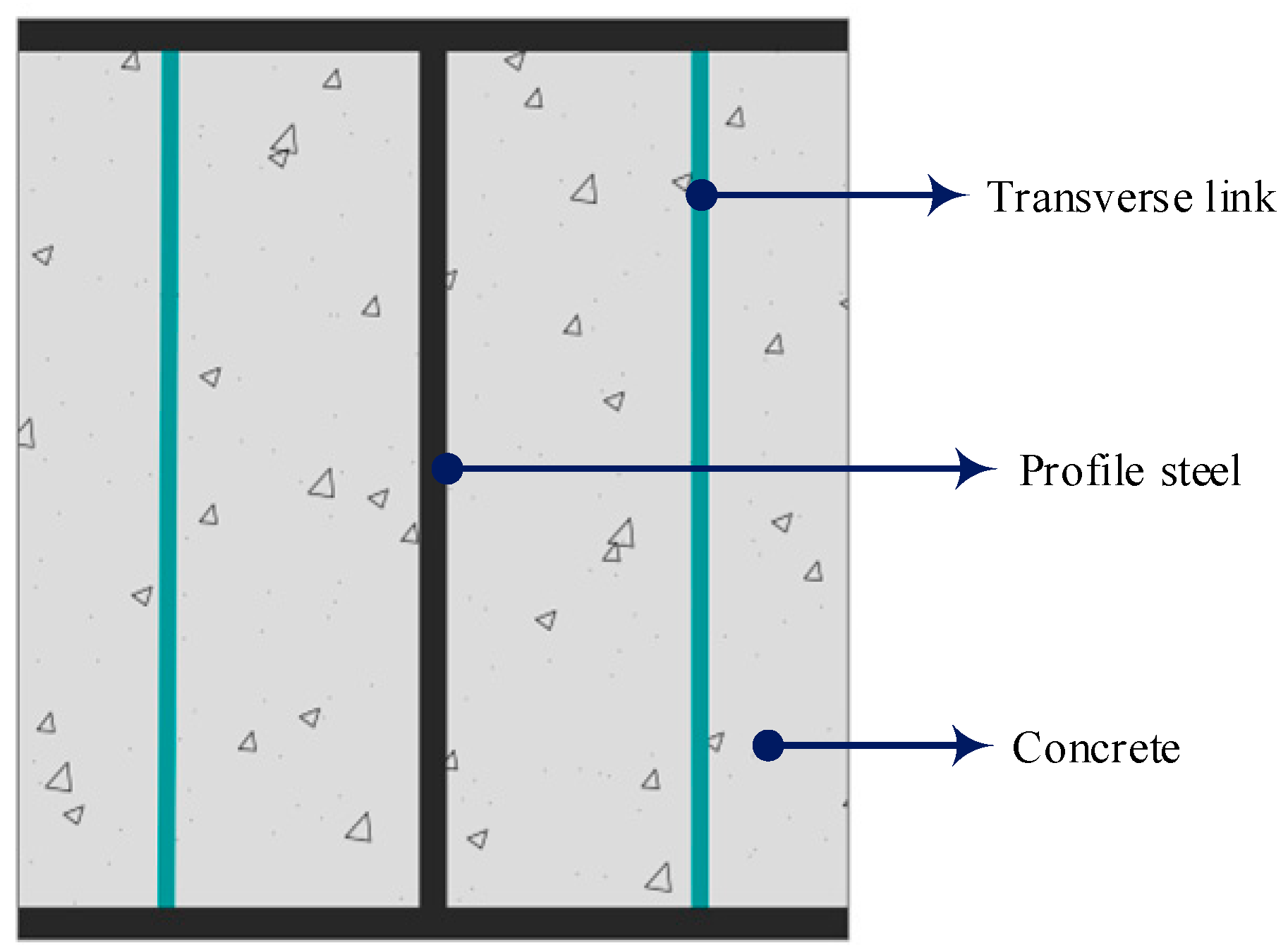

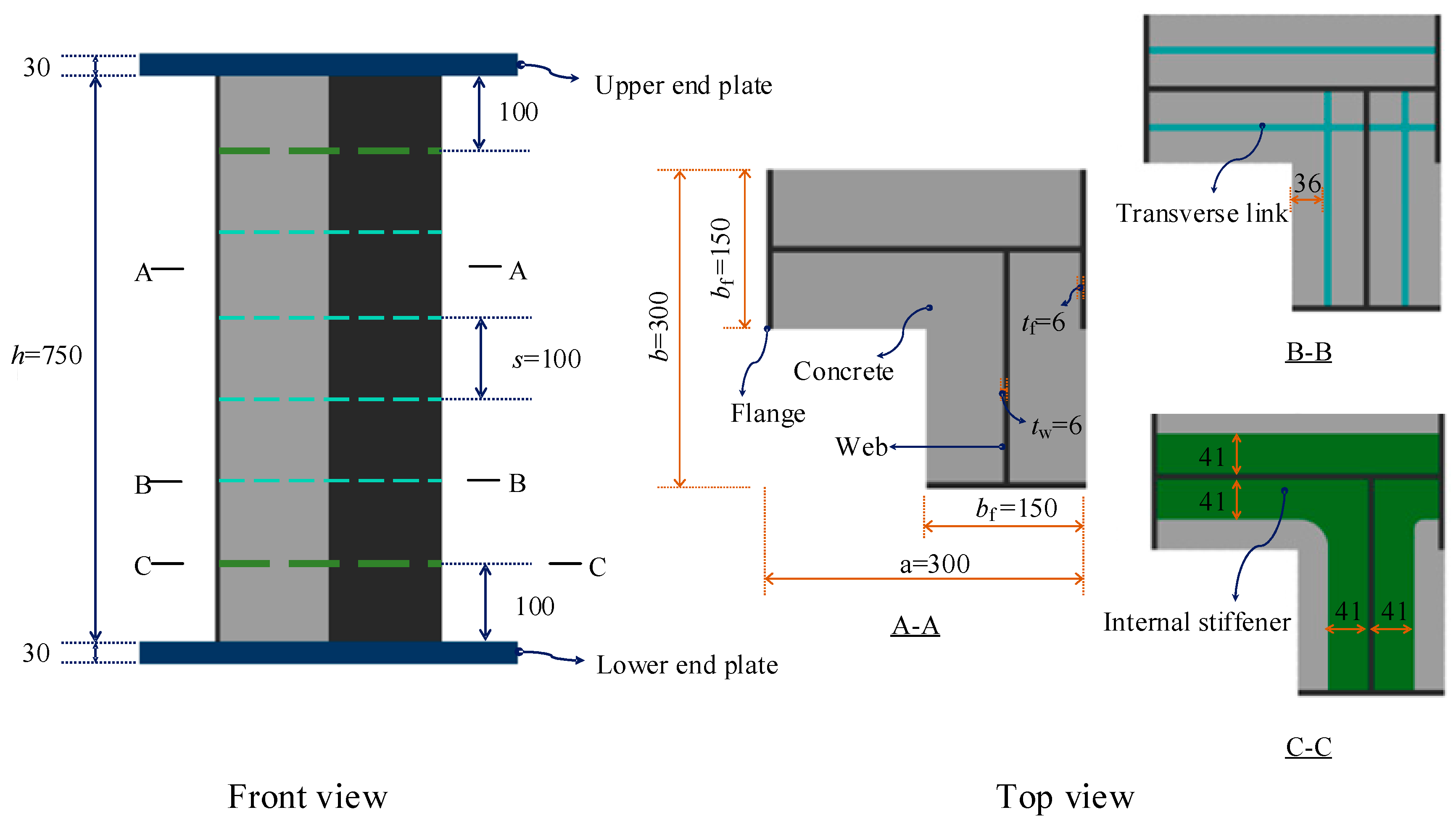

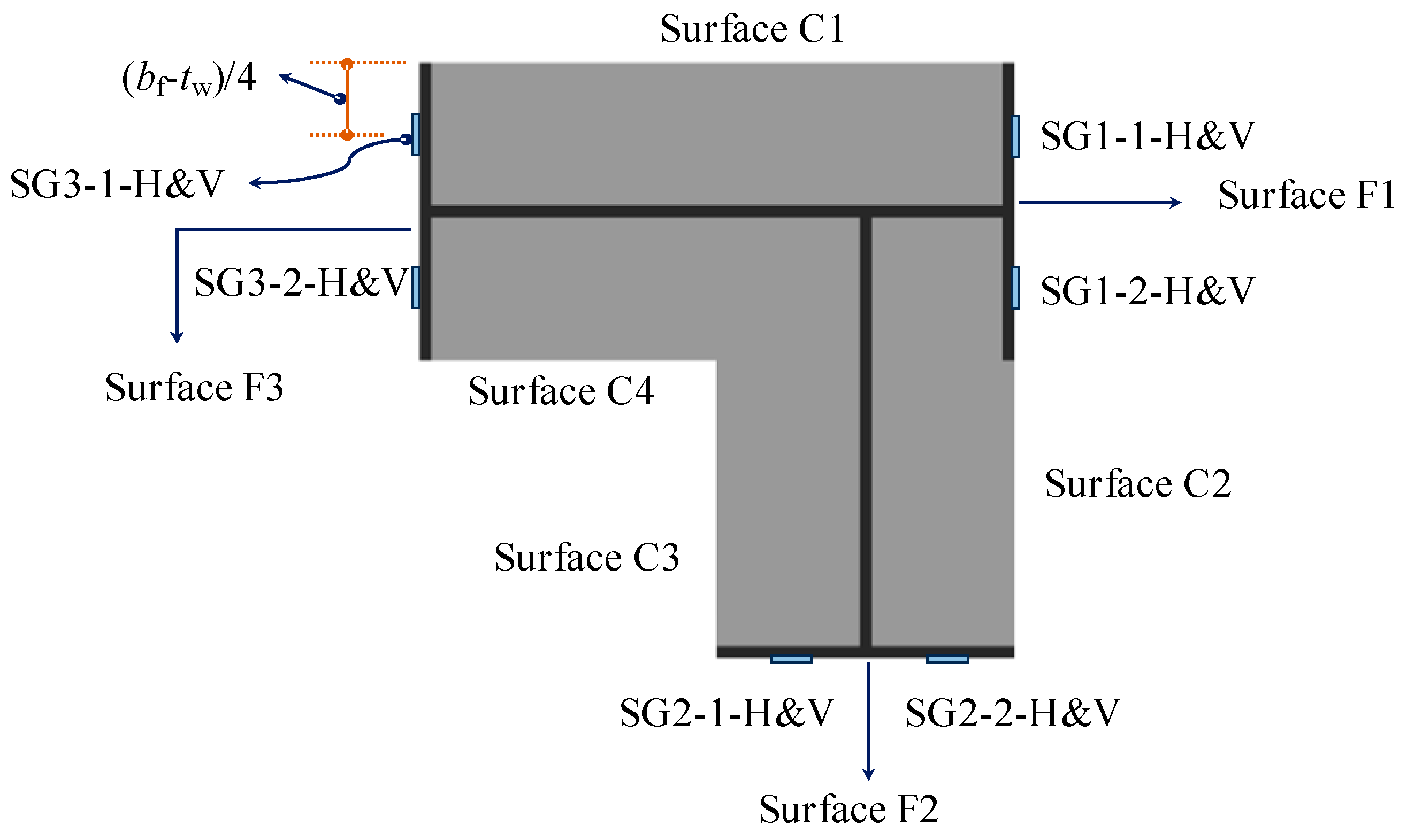


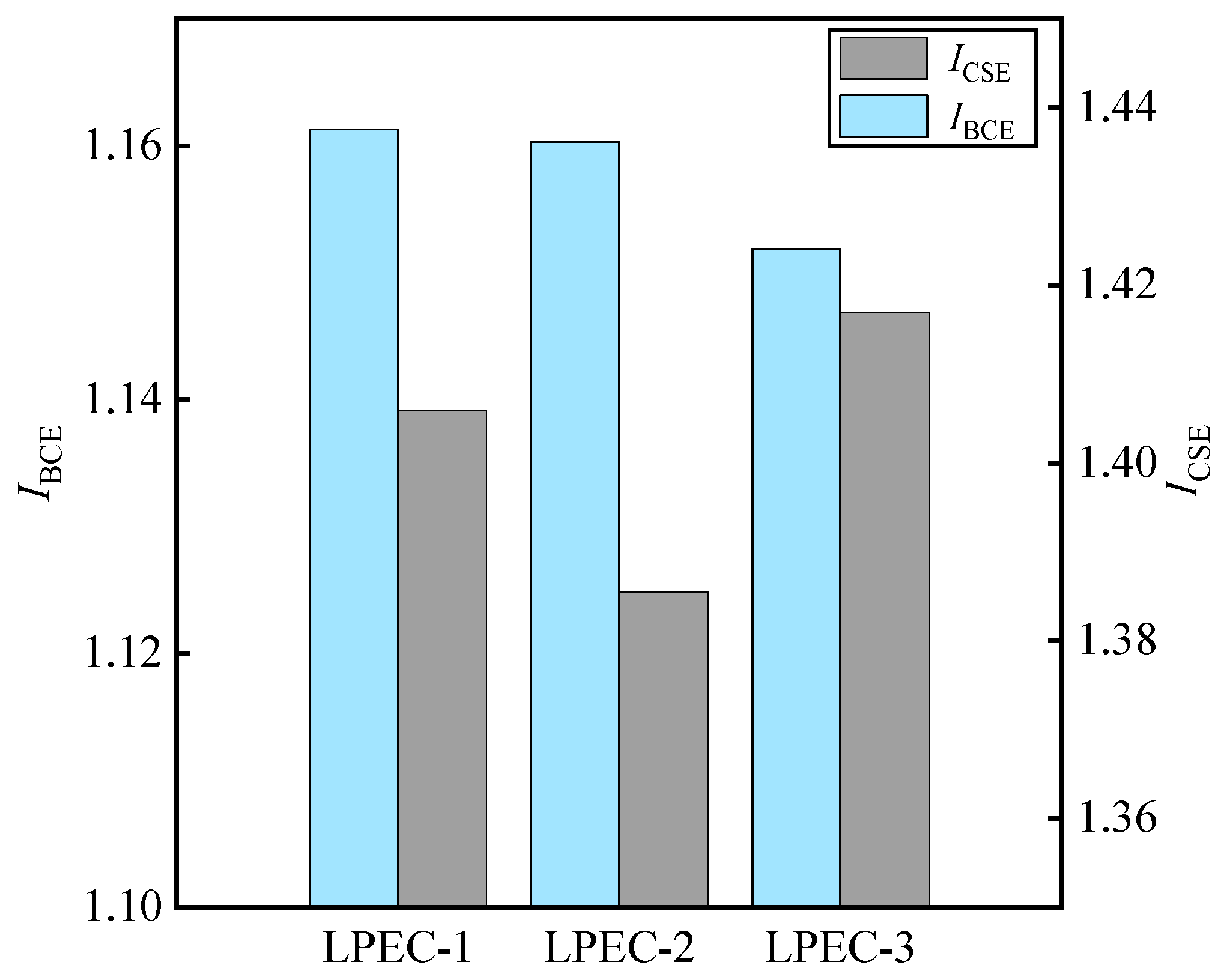


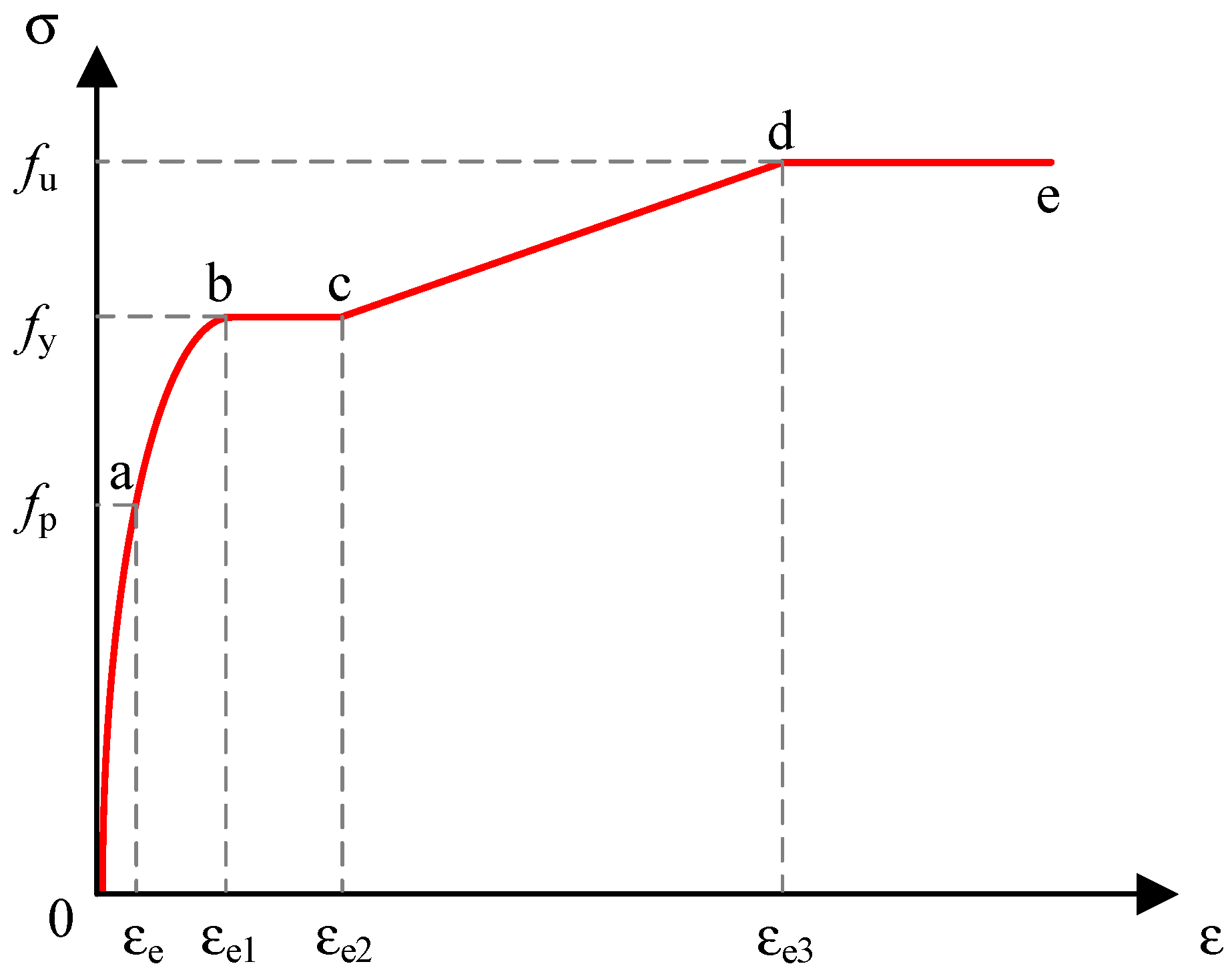
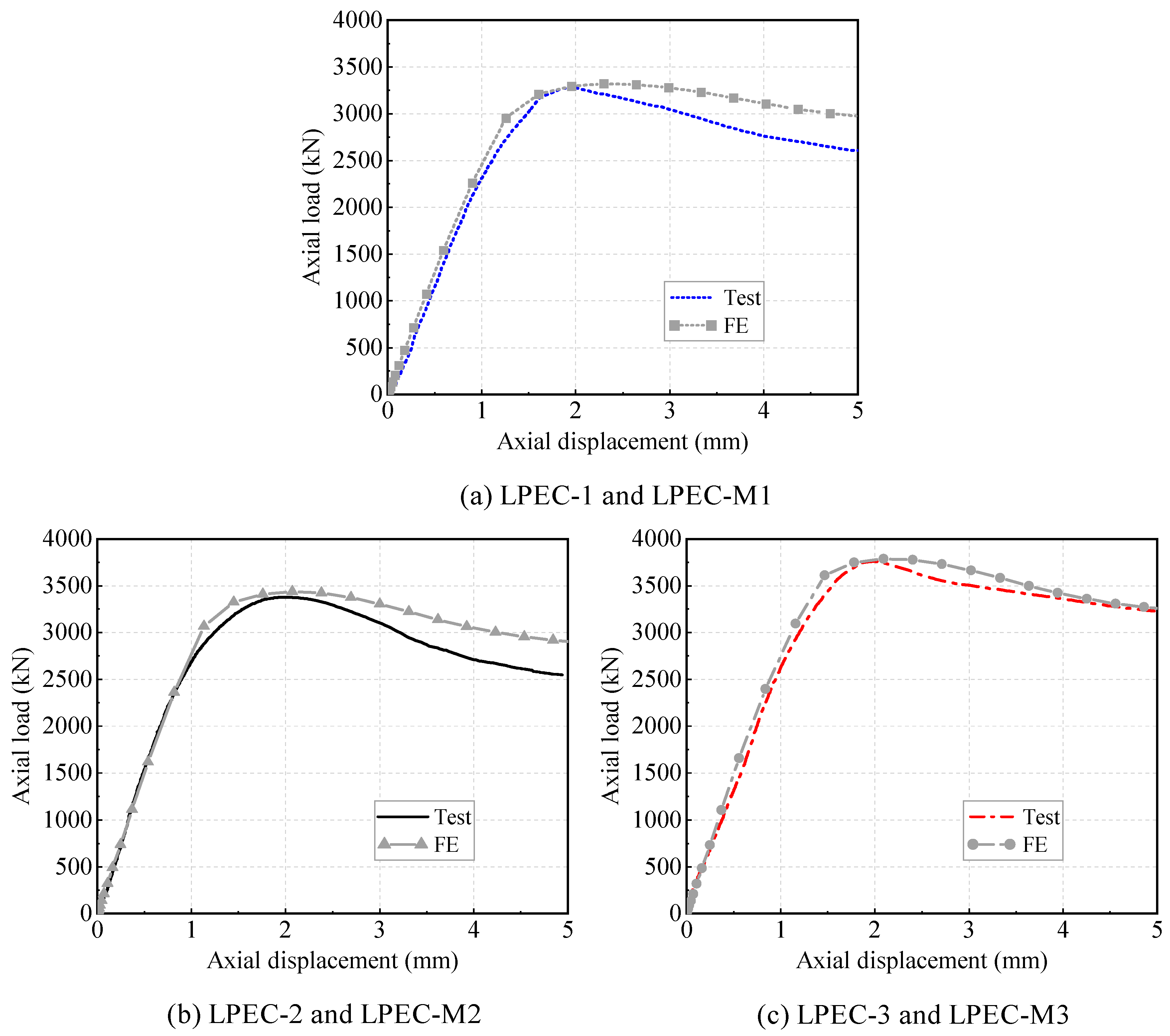
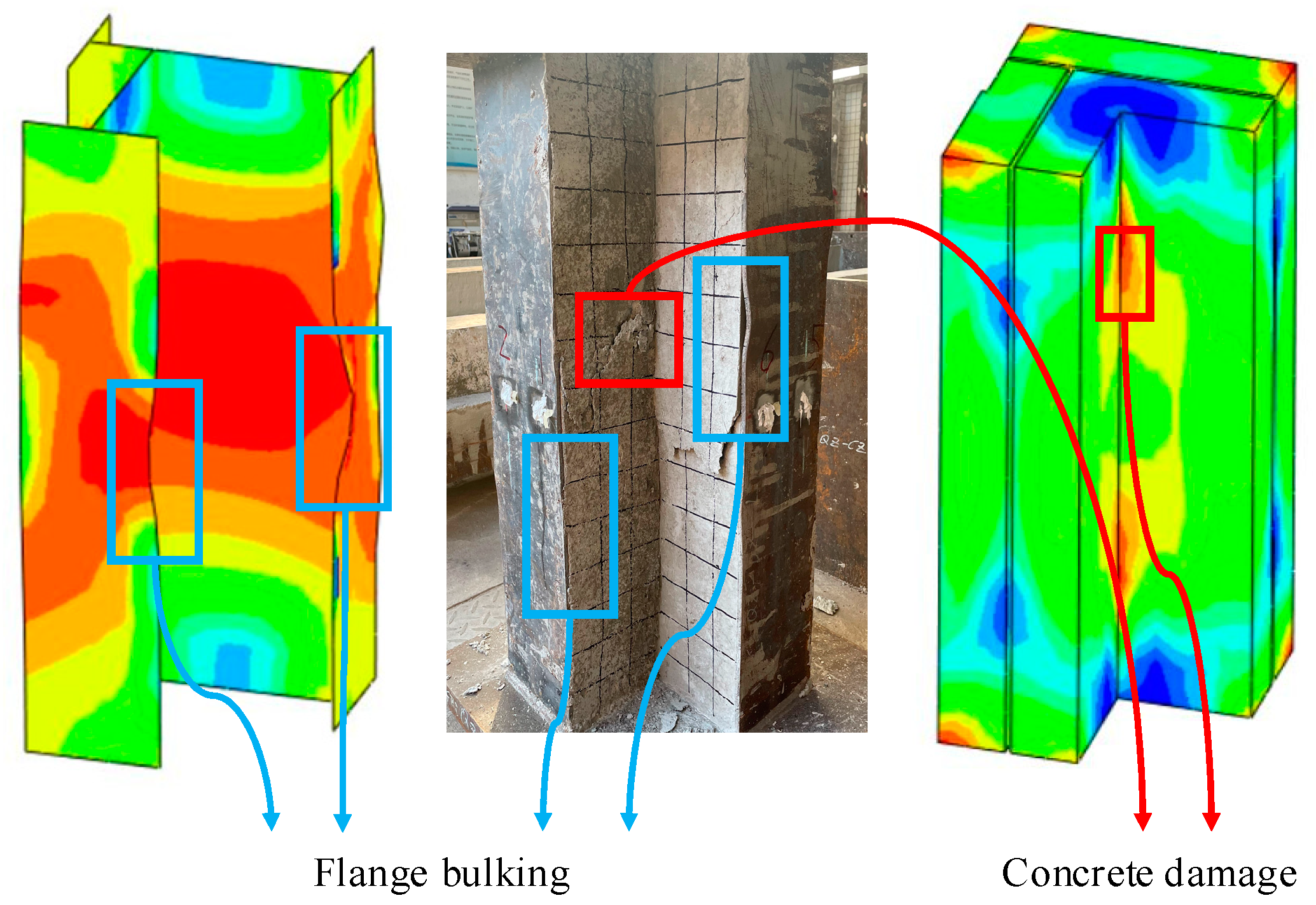
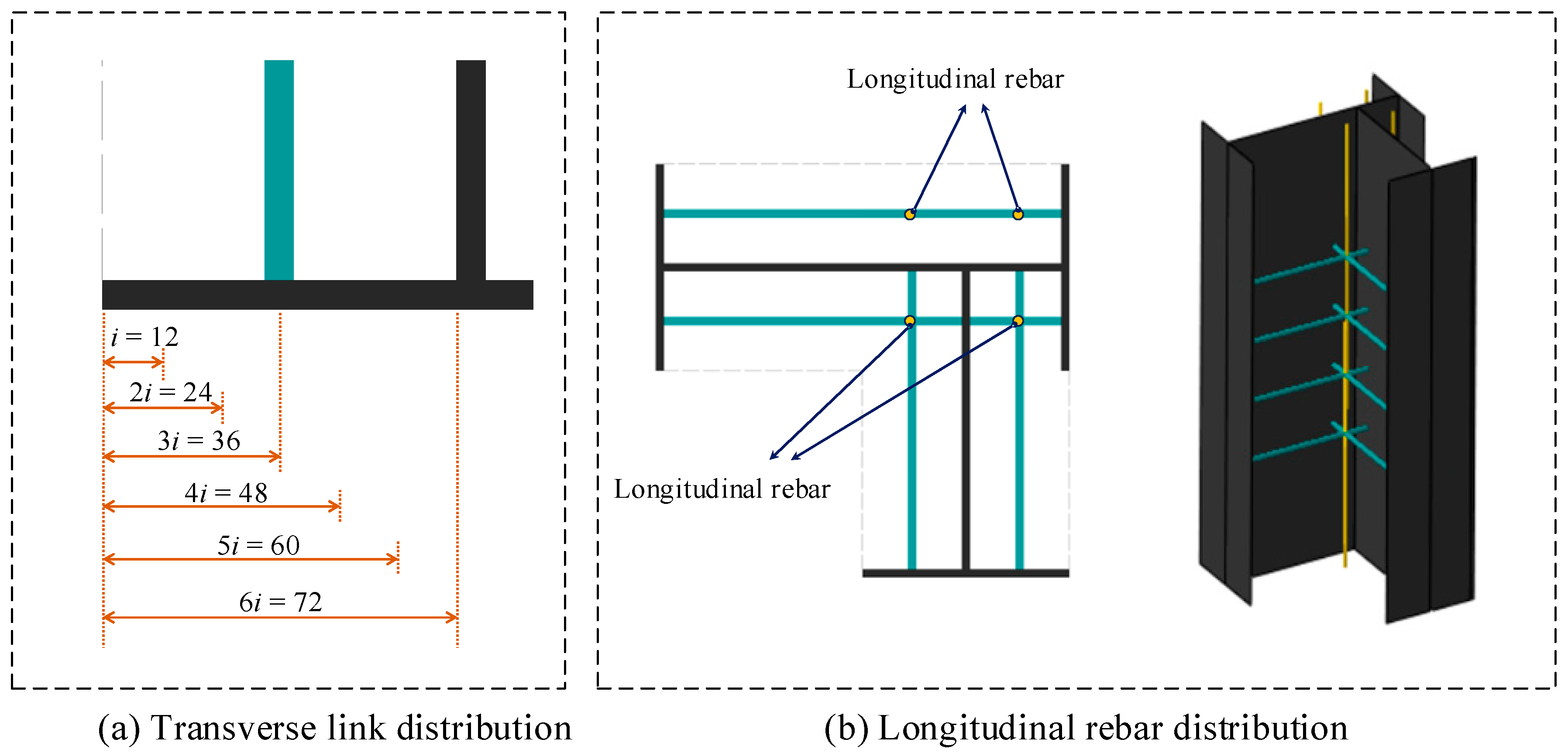


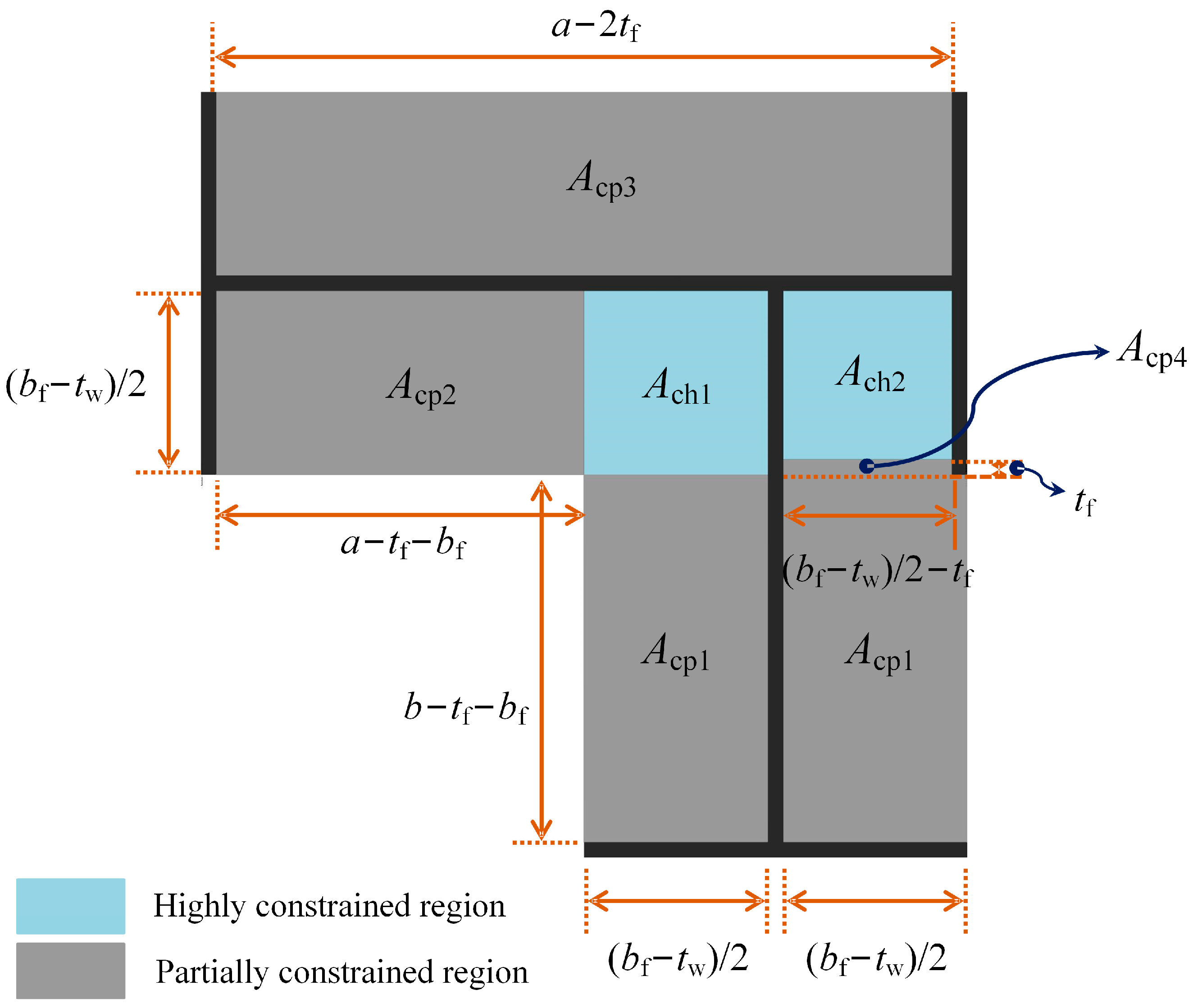
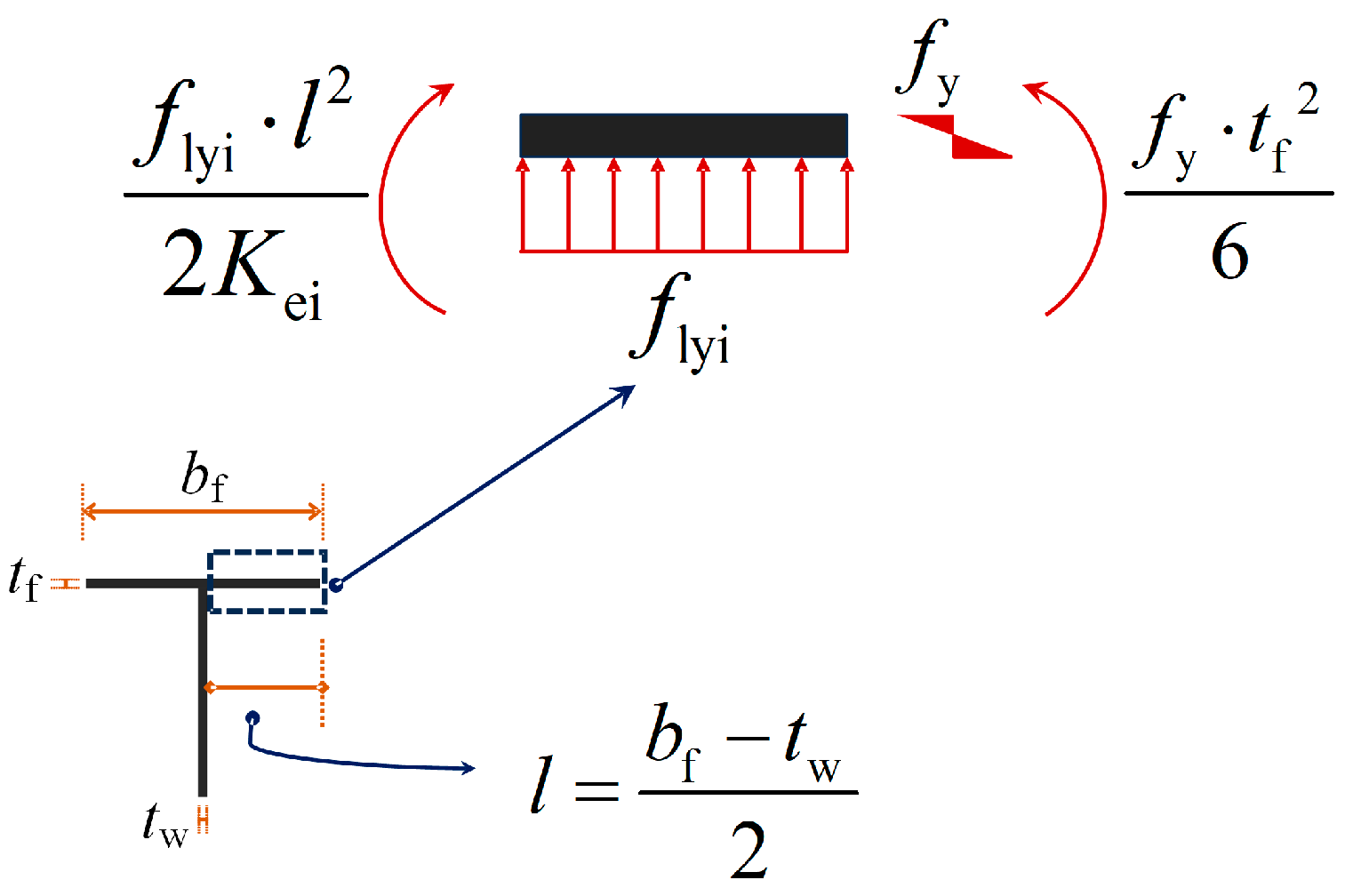

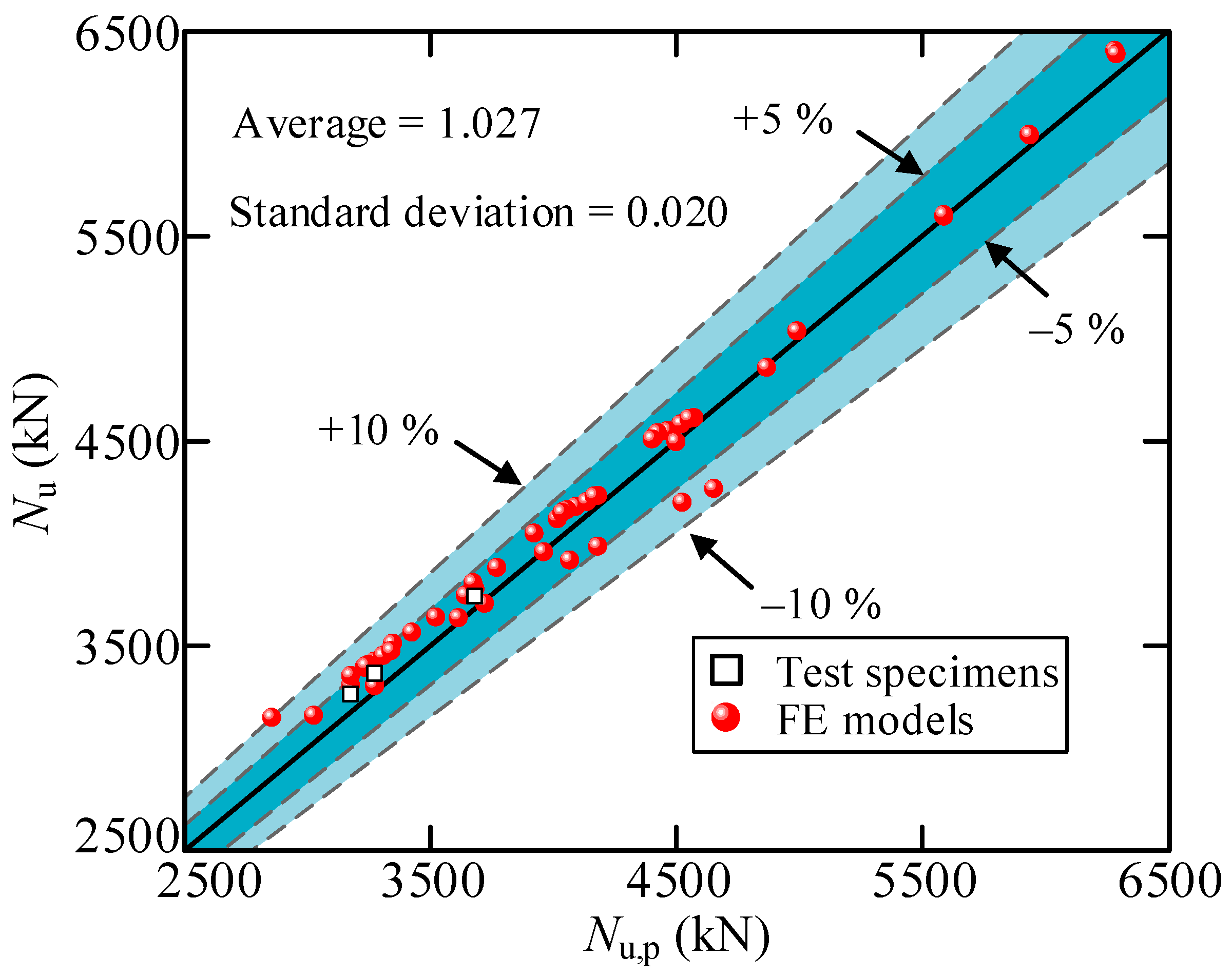
| Specimen Label | Concrete | Steel |
|---|---|---|
| LPEC-1 | C25 | Q290 |
| LPEC-2 | C30 | Q290 |
| LPEC-3 | C30 | Q345 |
| Specimen Label | As (mm2) | Ac (mm2) | Ar (mm2) | Nu (kN) | IBCE | ICSE |
|---|---|---|---|---|---|---|
| LPEC-1 | 5760 | 61,776 | 0 | 3278.51 | 1.161 | 1.4058 |
| LPEC-2 | 5760 | 61,776 | 0 | 3378.88 | 1.160 | 1.3854 |
| LPEC-3 | 5760 | 61,776 | 0 | 3763.61 | 1.152 | 1.4169 |
| Specimen Label | Concrete Strength (MPa) | Steel Strength (MPa) |
|---|---|---|
| LPEC-M1 | 18.16 | 295.37 |
| LPEC-M2 | 19.60 | 295.37 |
| LPEC-M3 | 19.60 | 355.54 |
| Parameter | Specimen Label | Steel Thickness | Concrete Strength (MPa) | Steel Strength (MPa) | Transverse Link Spacing (mm) | Transverse Link Diameter (mm) | Transverse Link Distribution | Longitudinal Rebar Diameter (mm) |
|---|---|---|---|---|---|---|---|---|
| tw × tf (mm) | ||||||||
| Flange | LPEC-F1 | 6 × 4 | 19.6 | 295.37 | 100 | 8 | 3i | / |
| LPEC-F2 | 6 × 8 | 19.6 | 295.37 | 100 | 8 | 3i | / | |
| LPEC-F3 | 6 × 10 | 19.6 | 295.37 | 100 | 8 | 3i | / | |
| LPEC-F4 | 6 × 12 | 19.6 | 295.37 | 100 | 8 | 3i | / | |
| Web | LPEC-W1 | 4 × 6 | 19.6 | 295.37 | 100 | 8 | 3i | / |
| LPEC-W2 | 8 × 6 | 19.6 | 295.37 | 100 | 8 | 3i | / | |
| LPEC-W3 | 10 × 6 | 19.6 | 295.37 | 100 | 8 | 3i | / | |
| LPEC-W4 | 12 × 6 | 19.6 | 295.37 | 100 | 8 | 3i | / | |
| Concrete | LPEC-C1 | 6 × 6 | 20.1 | 345 | 100 | 8 | 3i | / |
| LPEC-C2 | 6 × 6 | 26.8 | 345 | 100 | 8 | 3i | / | |
| LPEC-C3 | 6 × 6 | 32.4 | 345 | 100 | 8 | 3i | / | |
| Steel | LPEC-S1 | 6 × 6 | 26.8 | 235 | 100 | 8 | 3i | / |
| LPEC-S2 | 6 × 6 | 26.8 | 460 | 100 | 8 | 3i | / | |
| Transverse link | LPEC-L1 | 6 × 6 | 19.6 | 295.37 | 50 | 8 | 3i | / |
| LPEC-L2 | 6 × 6 | 19.6 | 295.37 | 150 | 8 | 3i | / | |
| LPEC-L3 | 6 × 6 | 19.6 | 295.37 | 200 | 8 | 3i | / | |
| LPEC-L4 | 6 × 6 | 19.6 | 295.37 | / | / | / | / | |
| LPEC-L5 | 6 × 6 | 19.6 | 295.37 | 100 | 6 | 3i | / | |
| LPEC-L6 | 6 × 6 | 19.6 | 295.37 | 100 | 10 | 3i | / | |
| LPEC-L7 | 6 × 6 | 19.6 | 295.37 | 100 | 12 | 3i | / | |
| LPEC-L8 | 6 × 6 | 19.6 | 295.37 | 100 | 8 | 5i | / | |
| LPEC-L9 | 6 × 6 | 19.6 | 295.37 | 100 | 8 | 4i | / | |
| LPEC-L10 | 6 × 6 | 19.6 | 295.37 | 100 | 8 | 2i | / | |
| LPEC-L11 | 6 × 6 | 19.6 | 295.37 | 100 | 8 | i | / | |
| Longitudinal rebar | LPEC-R1 | 6 × 6 | 19.6 | 295.37 | 100 | 8 | 3i | 6 |
| LPEC-R2 | 6 × 6 | 19.6 | 295.37 | 100 | 8 | 3i | 8 | |
| LPEC-R3 | 6 × 6 | 19.6 | 295.37 | 100 | 8 | 3i | 10 | |
| LPEC-R4 | 6 × 6 | 19.6 | 295.37 | 100 | 8 | 3i | 12 |
| Parameters | Specimen Label | As (mm2) | Ac (mm2) | Ar (mm2) | Nu (kN) | Nu-fyAs-frAr (kN) | fcAc (kN) | ICSE |
|---|---|---|---|---|---|---|---|---|
| Validation | LPEC-M1 | 5760 | 61,776 | 0 | 3320.20 | 1618.86 | 1121.85 | 1.4430 |
| LPEC-M2 | 5760 | 61,776 | 0 | 3439.86 | 1738.52 | 1210.81 | 1.4358 | |
| LPEC-M3 | 5760 | 61,776 | 0 | 3789.75 | 1741.83 | 1210.81 | 1.4385 | |
| Flange | LPEC-F1 | 4884 | 62,652 | 0 | 3201.30 | 1758.71 | 1227.97 | 1.4322 |
| LPEC-F2 | 6636 | 60,900 | 0 | 3679.62 | 1719.54 | 1193.64 | 1.4405 | |
| LPEC-F3 | 7512 | 60,024 | 0 | 3918.13 | 1699.31 | 1176.47 | 1.4444 | |
| LPEC-F4 | 8388 | 59,148 | 0 | 4156.52 | 1678.95 | 1159.30 | 1.4482 | |
| Web | LPEC-W1 | 4774 | 62,762 | 0 | 3163.49 | 1753.39 | 1230.48 | 1.4249 |
| LPEC-W2 | 6772 | 60,764 | 0 | 3718.31 | 1718.06 | 1191.21 | 1.4422 | |
| LPEC-W3 | 7780 | 59,756 | 0 | 3996.93 | 1698.95 | 1171.68 | 1.4500 | |
| LPEC-W4 | 8784 | 58,752 | 0 | 4276.66 | 1682.12 | 1152.24 | 1.4598 | |
| Concrete | LPEC-C1 | 5760 | 61,776 | 0 | 3759.04 | 1771.84 | 1241.69 | 1.4269 |
| LPEC-C2 | 5760 | 61,776 | 0 | 4188.92 | 2201.72 | 1655.59 | 1.3298 | |
| LPEC-C3 | 5760 | 61,776 | 0 | 4556.98 | 2569.78 | 2001.54 | 1.2839 | |
| Steel | LPEC-S1 | 5760 | 61,776 | 0 | 3526.69 | 2173.09 | 1655.59 | 1.3125 |
| LPEC-S2 | 5760 | 61,776 | 0 | 4864.61 | 2215.01 | 1655.59 | 1.3378 | |
| Transverse link | LPEC-L1 | 5760 | 61,776 | 0 | 3484.29 | 1782.95 | 1210.81 | 1.4725 |
| LPEC-L2 | 5760 | 61,776 | 0 | 3421.20 | 1719.86 | 1210.81 | 1.4204 | |
| LPEC-L3 | 5760 | 61,776 | 0 | 3407.93 | 1706.59 | 1210.81 | 1.4094 | |
| LPEC-L4 | 5760 | 61,776 | 0 | 3369.39 | 1668.05 | 1210.81 | 1.3776 | |
| LPEC-L5 | 5760 | 61,776 | 0 | 3415.72 | 1714.38 | 1210.81 | 1.4159 | |
| LPEC-L6 | 5760 | 61,776 | 0 | 3464.01 | 1762.67 | 1210.81 | 1.4557 | |
| LPEC-L7 | 5760 | 61,776 | 0 | 3487.44 | 1786.10 | 1210.81 | 1.4751 | |
| LPEC-L8 | 5760 | 61,776 | 0 | 3440.79 | 1618.31 | 1210.81 | 1.4366 | |
| LPEC-L9 | 5760 | 61,776 | 0 | 3444.88 | 1623.00 | 1210.81 | 1.4399 | |
| LPEC-L10 | 5760 | 61,776 | 0 | 3442.58 | 1622.72 | 1210.81 | 1.4380 | |
| LPEC-L11 | 5760 | 61,776 | 0 | 3438.61 | 1615.88 | 1210.81 | 1.4348 | |
| Longitudinal rebar | LPEC-R1 | 5760 | 61,662 | 114 | 3473.41 | 1738.15 | 1208.59 | 1.4381 |
| LPEC-R2 | 5760 | 61,574 | 202 | 3499.15 | 1737.50 | 1206.86 | 1.4396 | |
| LPEC-R3 | 5760 | 61,461 | 315 | 3532.78 | 1737.20 | 1204.65 | 1.4420 | |
| LPEC-R4 | 5760 | 61,323 | 454 | 3573.60 | 1736.55 | 1201.94 | 1.4447 |
| Specimen Label | Nu (kN) | Nu,CECS (kN) | Nu,EC4 (kN) | Nu/Nu,CECS | Nu/Nu,EC4 | |
|---|---|---|---|---|---|---|
| Test | LPEC-1 | 3278.51 | 2823.18 | 2825.69 | 1.161 | 1.160 |
| LPEC-2 | 3378.88 | 2912.14 | 2914.85 | 1.160 | 1.159 | |
| LPEC-3 | 3753.62 | 3258.72 | 3261.43 | 1.152 | 1.151 | |
| FE models | LPEC-M1 | 3320.20 | 2823.18 | 2825.69 | 1.176 | 1.175 |
| LPEC-M2 | 3439.86 | 2912.14 | 2914.85 | 1.181 | 1.180 | |
| LPEC-M3 | 3789.75 | 3258.72 | 3261.43 | 1.163 | 1.162 | |
| LPEC-F1 | 3174.40 | 2670.33 | 2673.08 | 1.189 | 1.188 | |
| LPEC-F2 | 3652.72 | 3153.95 | 3156.62 | 1.158 | 1.157 | |
| LPEC-F3 | 3891.23 | 3395.76 | 3398.40 | 1.146 | 1.145 | |
| LPEC-F4 | 4129.62 | 3637.57 | 3640.17 | 1.135 | 1.134 | |
| LPEC-W1 | 3163.49 | 2640.58 | 2643.34 | 1.198 | 1.197 | |
| LPEC-W2 | 3718.31 | 3191.46 | 3194.12 | 1.165 | 1.164 | |
| LPEC-W3 | 3996.93 | 3469.67 | 3472.29 | 1.152 | 1.151 | |
| LPEC-W4 | 4276.66 | 3746.77 | 3749.35 | 1.141 | 1.141 | |
| LPEC-C1 | 3759.04 | 3228.90 | 3231.68 | 1.164 | 1.163 | |
| LPEC-C2 | 4188.92 | 3642.80 | 3646.50 | 1.150 | 1.149 | |
| LPEC-C3 | 4556.98 | 3988.74 | 3993.22 | 1.142 | 1.141 | |
| LPEC-S1 | 3526.69 | 3009.20 | 3012.90 | 1.172 | 1.171 | |
| LPEC-S2 | 4864.61 | 4305.20 | 4308.90 | 1.130 | 1.129 | |
| LPEC-L1 | 3484.29 | 2912.14 | 2914.85 | 1.196 | 1.195 | |
| LPEC-L2 | 3421.20 | 2912.14 | 2914.85 | 1.175 | 1.174 | |
| LPEC-L3 | 3407.93 | 2912.14 | 2914.85 | 1.170 | 1.169 | |
| LPEC-L4 | 3369.39 | 2912.14 | 2914.85 | 1.157 | 1.156 | |
| LPEC-L5 | 3415.72 | 2912.14 | 2914.85 | 1.173 | 1.172 | |
| LPEC-L6 | 3464.01 | 2912.14 | 2914.85 | 1.190 | 1.188 | |
| LPEC-L7 | 3487.44 | 2912.14 | 2914.85 | 1.198 | 1.196 | |
| LPEC-L8 | 3440.79 | 2912.14 | 2914.85 | 1.182 | 1.180 | |
| LPEC-L9 | 3444.88 | 2912.14 | 2914.85 | 1.183 | 1.182 | |
| LPEC-L10 | 3442.58 | 2912.14 | 2914.85 | 1.182 | 1.181 | |
| LPEC-L11 | 3438.61 | 2912.14 | 2914.85 | 1.181 | 1.180 | |
| Average | 1.167 | 1.166 | ||||
| Standard deviation | 0.018 | 0.018 |
| Specimen Label | Steel Dimension | Concrete Strength (MPa) | Steel Strength (MPa) | Transverse Link Spacing (mm) | Transverse Link Diameter (mm) |
|---|---|---|---|---|---|
| a × b × bf × tw × tf (mm) | |||||
| LPEC-F6 | 300 × 300 × 150 × 6 × 8 | 19.6 | 295.37 | / | / |
| LPEC-F7 | 300 × 300 × 150 × 6 × 10 | 19.6 | 295.37 | / | / |
| LPEC-F8 | 300 × 300 × 150 × 6 × 12 | 19.6 | 295.37 | / | / |
| LPEC-W6 | 300 × 300 × 150 × 8 × 6 | 19.6 | 295.37 | / | / |
| LPEC-W7 | 300 × 300 × 150 × 10 × 6 | 19.6 | 295.37 | / | / |
| LPEC-W8 | 300 × 300 × 150 × 12 × 6 | 19.6 | 295.37 | / | / |
| LPEC-L12 | 300 × 300 × 150 × 6 × 6 | 26.8 | 345 | 100 | 6 |
| LPEC-L13 | 300 × 300 × 150 × 6 × 6 | 26.8 | 345 | 100 | 10 |
| LPEC-L14 | 300 × 300 × 150 × 6 × 6 | 26.8 | 345 | 100 | 12 |
| LPEC-L15 | 300 × 300 × 150 × 6 × 6 | 32.4 | 345 | 100 | 6 |
| LPEC-L16 | 300 × 300 × 150 × 6 × 6 | 32.4 | 345 | 100 | 10 |
| LPEC-L17 | 300 × 300 × 150 × 6 × 6 | 32.4 | 345 | 100 | 12 |
| LPEC-L18 | 300 × 300 × 150 × 6 × 6 | 26.8 | 345 | 50 | 8 |
| LPEC-L19 | 300 × 300 × 150 × 6 × 6 | 26.8 | 345 | 150 | 8 |
| LPEC-L20 | 300 × 300 × 150 × 6 × 6 | 26.8 | 345 | 200 | 8 |
| LPEC-L21 | 300 × 300 × 150 × 6 × 6 | 32.4 | 345 | 50 | 8 |
| LPEC-L22 | 300 × 300 × 150 × 6 × 6 | 32.4 | 345 | 150 | 8 |
| LPEC-L23 | 300 × 300 × 150 × 6 × 6 | 32.4 | 345 | 200 | 8 |
| LPEC-UN1 | 300 × 400 × 150 × 6 × 6 | 26.8 | 345 | 100 | 8 |
| LPEC-UN2 | 300 × 450 × 150 × 6 × 6 | 26.8 | 345 | 100 | 8 |
| LPEC-UN3 | 300 × 500 × 150 × 6 × 6 | 26.8 | 345 | 100 | 8 |
| LPEC-UN4 | 400 × 300 × 150 × 6 × 6 | 26.8 | 345 | 100 | 8 |
| LPEC-UN5 | 450 × 300 × 150 × 6 × 6 | 26.8 | 345 | 100 | 8 |
| LPEC-UN6 | 500 × 300 × 150 × 6 × 6 | 26.8 | 345 | 100 | 8 |
| LPEC-FW2 | 300 × 300 × 150 × 8 × 8 | 19.6 | 295.37 | 100 | 8 |
| LPEC-FW3 | 300 × 300 × 150 × 10 × 10 | 19.6 | 295.37 | 100 | 8 |
| LPEC-FW4 | 300 × 300 × 150 × 12 × 12 | 19.6 | 295.37 | 100 | 8 |
| Specimen Label | Nu (kN) | Nu,p (kN) | Nu/Nu,p | |
|---|---|---|---|---|
| Test | LPEC-1 | 3278.51 | 3187.81 | 1.028 |
| LPEC-2 | 3378.88 | 3283.38 | 1.029 | |
| LPEC-3 | 3753.62 | 3687.19 | 1.018 | |
| FE models | LPEC-M1 | 3320.20 | 3187.81 | 1.042 |
| LPEC-M2 | 3439.86 | 3283.38 | 1.048 | |
| LPEC-M3 | 3789.75 | 3687.19 | 1.028 | |
| LPEC-F1 | 3174.40 | 3036.93 | 1.045 | |
| LPEC-F2 | 3652.72 | 3529.62 | 1.035 | |
| LPEC-F3 | 3891.23 | 3775.63 | 1.031 | |
| LPEC-F4 | 4129.62 | 4021.41 | 1.027 | |
| LPEC-W1 | 3163.49 | 2868.16 | 1.103 | |
| LPEC-W2 | 3718.31 | 3726.65 | 0.998 | |
| LPEC-W3 | 3996.93 | 4185.48 | 0.990 | |
| LPEC-W4 | 4276.66 | 4651.62 | 0.995 | |
| LPEC-C1 | 3759.04 | 3649.67 | 1.030 | |
| LPEC-C2 | 4188.92 | 4094.24 | 1.023 | |
| LPEC-C3 | 4556.98 | 4465.48 | 1.020 | |
| LPEC-S1 | 3526.69 | 3355.10 | 1.051 | |
| LPEC-S2 | 4864.61 | 4866.23 | 1.000 | |
| LPEC-L1 | 3484.29 | 3339.58 | 1.043 | |
| LPEC-L2 | 3421.20 | 3258.11 | 1.050 | |
| LPEC-L3 | 3407.93 | 3243.46 | 1.051 | |
| LPEC-L4 | 3369.39 | 3186.27 | 1.057 | |
| LPEC-L5 | 3415.72 | 3249.14 | 1.051 | |
| LPEC-L6 | 3464.01 | 3317.70 | 1.044 | |
| LPEC-L7 | 3487.44 | 3350.72 | 1.041 | |
| LPEC-L8 | 3319.65 | 3440.79 | 1.048 | |
| LPEC-L9 | 3324.34 | 3444.88 | 1.049 | |
| LPEC-L10 | 3324.06 | 3442.58 | 1.048 | |
| LPEC-L11 | 3317.22 | 3438.61 | 1.047 | |
| LPEC-F6 | 3579.79 | 3433.28 | 1.043 | |
| LPEC-F7 | 3819.44 | 3680.07 | 1.038 | |
| LPEC-F8 | 4058.79 | 3926.64 | 1.034 | |
| LPEC-W6 | 3649.10 | 3620.67 | 1.008 | |
| LPEC-W7 | 3929.97 | 4069.61 | 1.000 | |
| LPEC-W8 | 4210.60 | 4525.35 | 1.004 | |
| LPEC-L12 | 4164.89 | 4048.63 | 1.029 | |
| LPEC-L13 | 4213.03 | 4139.95 | 1.018 | |
| LPEC-L14 | 4243.23 | 4183.92 | 1.014 | |
| LPEC-L15 | 4525.29 | 4411.84 | 1.026 | |
| LPEC-L16 | 4589.00 | 4519.25 | 1.015 | |
| LPEC-L17 | 4619.05 | 4570.97 | 1.011 | |
| LPEC-L18 | 4240.32 | 4169.09 | 1.017 | |
| LPEC-L19 | 4173.40 | 4060.58 | 1.028 | |
| LPEC-L20 | 4160.10 | 4041.06 | 1.029 | |
| LPEC-L21 | 4618.16 | 4553.52 | 1.014 | |
| LPEC-L22 | 4545.29 | 4425.89 | 1.027 | |
| LPEC-L23 | 4515.54 | 4402.94 | 1.026 | |
| LPEC-UN1 | 5598.07 | 5579.38 | 1.003 | |
| LPEC-UN2 | 5997.42 | 5924.84 | 1.012 | |
| LPEC-UN3 | 6401.77 | 6270.29 | 1.021 | |
| LPEC-UN4 | 5606.12 | 5581.42 | 1.004 | |
| LPEC-UN5 | 5992.22 | 5927.89 | 1.011 | |
| LPEC-UN6 | 6386.36 | 6274.35 | 1.018 | |
| LPEC-FW2 | 3968.41 | 3966.01 | 1.001 | |
| LPEC-FW3 | 4503.83 | 4499.16 | 1.001 | |
| LPEC-FW4 | 5039.28 | 4986.27 | 1.011 | |
| Average | 1.027 | |||
| Standard deviation | 0.020 |
Disclaimer/Publisher’s Note: The statements, opinions and data contained in all publications are solely those of the individual author(s) and contributor(s) and not of MDPI and/or the editor(s). MDPI and/or the editor(s) disclaim responsibility for any injury to people or property resulting from any ideas, methods, instructions or products referred to in the content. |
© 2024 by the authors. Licensee MDPI, Basel, Switzerland. This article is an open access article distributed under the terms and conditions of the Creative Commons Attribution (CC BY) license (https://creativecommons.org/licenses/by/4.0/).
Share and Cite
Qi, Y.; Zhu, H.; Xu, Y.; Xiao, Z.; Jin, Z. Axial Compression Performance of L-Shaped Partially Encased Steel–Concrete Composite Stub Columns. Buildings 2024, 14, 3001. https://doi.org/10.3390/buildings14093001
Qi Y, Zhu H, Xu Y, Xiao Z, Jin Z. Axial Compression Performance of L-Shaped Partially Encased Steel–Concrete Composite Stub Columns. Buildings. 2024; 14(9):3001. https://doi.org/10.3390/buildings14093001
Chicago/Turabian StyleQi, Yuansen, Haochuan Zhu, Youwu Xu, Zhibin Xiao, and Zhenfen Jin. 2024. "Axial Compression Performance of L-Shaped Partially Encased Steel–Concrete Composite Stub Columns" Buildings 14, no. 9: 3001. https://doi.org/10.3390/buildings14093001






